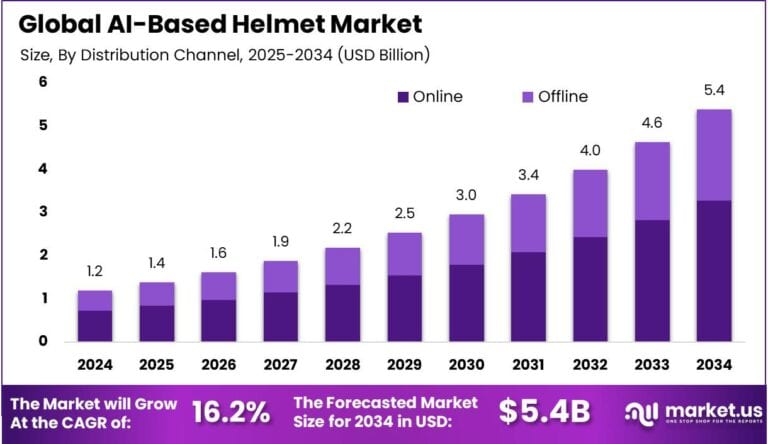Table of Contents
Introduction
The global AI-based helmet market is projected to grow from USD 1.2 billion in 2024 to USD 5.4 billion by 2034, registering a CAGR of 16.2%. In 2024, North America dominated with a 32.8% market share, generating USD 0.39 billion in revenue. The U.S. segment accounted for USD 0.38 billion, with an expected CAGR of 14.3%. The increasing adoption of AI technologies in safety equipment, rising awareness about occupational hazards, and growing demand from industries such as construction, manufacturing, and mining are driving market growth globally.

How Tariffs Are Impacting the Economy
Tariffs on AI-based helmet components, sensors, and related electronics increase manufacturing costs, leading to higher prices for consumers and businesses. Elevated costs can slow adoption rates, especially in price-sensitive markets, affecting overall industry growth. Additionally, tariffs disrupt global supply chains, compelling manufacturers to seek alternative suppliers or relocate production, often incurring higher operational expenses and extended lead times.
➤ Discover how our research uncovers business opportunities @ https://market.us/report/ai-based-helmet-market/free-sample/
(Use corporate mail ID for quicker response)
Retaliatory tariffs escalate trade tensions, increasing market uncertainty and reducing investments in innovation. These economic challenges limit infrastructure upgrades and delay deployment of advanced safety technologies, ultimately affecting worker safety and productivity across sectors reliant on AI-enhanced protective gear.

Impact on Global Businesses
Businesses manufacturing AI-based helmets face increased component costs due to tariffs, impacting profit margins and pricing strategies. Supply chain shifts toward diversification or localization add operational complexity and capital investment needs. Industrial sectors such as construction, mining, and manufacturing encounter delays in integrating advanced helmets, impacting safety compliance and operational efficiency. Emerging markets, heavily dependent on imports, face affordability challenges, slowing adoption. Firms must innovate cost-effective production methods, optimize supply chains, and accelerate digital transformation to remain competitive in a tariff-influenced environment.
Strategies for Businesses
To counter tariff impacts, businesses diversify suppliers and explore local manufacturing options to reduce dependency on tariff-affected imports. Investments in modular designs and standardization lower production costs. Utilizing cloud-based platforms for firmware updates and AI enhancements minimizes hardware changes. Predictive analytics optimize inventory and anticipate tariff shifts. Forming strategic partnerships with regional players improves supply chain resilience. Active policy engagement aims to influence favorable trade conditions. Agility, technological innovation, and collaboration are essential to sustaining growth in a volatile trade landscape.
➤ Get full access now @ https://market.us/purchase-report/?report_id=148850
Key Takeaways
- AI-based helmet market expected to grow at 16.2% CAGR through 2034
- Tariffs increase production costs and disrupt component supply chains
- Safety equipment adoption delays affect multiple industrial sectors
- Supply chain diversification and modular design mitigate tariff impacts
- Predictive analytics enable proactive tariff risk management
Analyst Viewpoint
The AI-based helmet market is on a strong growth trajectory driven by rising safety awareness and AI technology integration. Although tariffs pose cost and supply chain challenges, they accelerate innovation in modular designs and local production. Market players are leveraging digital tools and strategic partnerships to sustain momentum. The outlook remains positive as demand for intelligent safety gear expands across industries globally, supported by regulatory mandates and technological advancements.
Regional Analysis
North America leads the AI-based helmet market with a 32.8% share in 2024, fueled by stringent workplace safety regulations and advanced industrial sectors. The U.S. dominates regional growth with significant investments in AI and IoT-enabled safety solutions. Europe shows steady growth driven by regulatory compliance and smart manufacturing initiatives. Asia-Pacific exhibits rapid expansion potential due to rising industrialization and growing safety awareness. Regional variations are influenced by regulatory frameworks, technology adoption rates, and industrial growth.
➤ Discover More Trending Research
Business Opportunities
Opportunities abound in developing customizable, AI-enabled helmets with features like real-time hazard detection and communication. Integration with IoT and wearable technologies expands functionality. Emerging markets offer growth potential through increasing industrial activities and safety regulations. Collaborations with industrial enterprises and safety regulators facilitate tailored solutions. Additionally, subscription-based models for software updates and data analytics services present new revenue streams. Sustainable and ergonomic design innovations also cater to evolving market demands.
Key Segmentation
Component
- Sensors and Cameras
- Processors and AI Chips
- Software
- Battery and Power Systems
Application
- Construction
- Mining
- Manufacturing
- Defense and Security
End User
- Industrial Workers
- Military Personnel
- Emergency Responders
Region
- North America
- Europe
- Asia-Pacific
- Rest of the World
Key Player Analysis
Leading companies focus on integrating advanced AI algorithms with robust hardware to enhance helmet functionality and user safety. R&D investments prioritize sensor accuracy, battery efficiency, and software usability. Partnerships with industrial firms and regulatory bodies accelerate product adoption. Market leaders emphasize scalability, customization, and compliance with safety standards. Expansion in emerging markets through localized manufacturing and service offerings strengthens competitive positioning. Continuous innovation and user-centric designs sustain market leadership.
Top Key Players in the Market
- Forcite Helmet Systems
- CrossHelmet (Borderless Inc.)
- Sena Technologies
- Jarvish Inc.
- Reevu
- DAQRI (Acquired by Snap Inc.)
- Intellinium
- Skully Technologies
- Livall
- HoloRide / Nreal Partnership
- Others
Recent Developments
In 2025, key players launched AI helmets with improved sensor fusion and augmented reality features. Strategic alliances with industrial safety organizations expanded market reach. Advances in battery technology extended device operational times.
Conclusion
The AI-based helmet market is poised for rapid growth, driven by technological innovation and increased safety awareness. While tariffs challenge cost structures and supply chains, strategic adaptations and digital integration will sustain market momentum. Continued investment and regional expansion will support future success.
Discuss your needs with our analyst
Please share your requirements with more details so our analyst can check if they can solve your problem(s)



